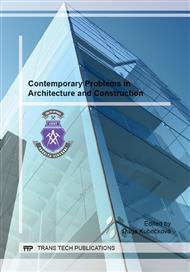[1]
J. Adamus, Forming drawn-parts from coated sheets (in Polish: Kształtowanie wytłoczek z blach powlekanych). Proceedings of the 14th Scientific and Technological Conference in Metal Forming, Poznań-Czerniejewo, Poland, (2000) 101-107.
Google Scholar
[2]
W. Gorecki, Engineering of producing and processing of flat metal products (Inżynieria wytwarzania i przetwórstwa płaskich wyrobów metalowych - in Polish). Silesian University of Technology Publishing House, Gliwice –Poland (2006).
Google Scholar
[3]
E. Dubuisson, P. Lavie, F. Dalard, J. -P. Caire, S. Szunerits, Corrosion of galvanised steel under an electrolytic drop, Corrosion Direct 49 (2007) 910-919.
DOI: 10.1016/j.corsci.2006.05.027
Google Scholar
[4]
PN-EN 10147: 2003: Strip and sheet of structural steel hot-dip galvanized in a continuous manner. Technical delivery conditions Taśmy i blachy ze stali konstrukcyjnej ocynkowane ogniowo w sposób ciągły. Warunki techniczne dostawy (in Polish).
Google Scholar
[5]
PN-EN 10169-1: 1998: Wyroby płaskie stalowe z powłoką organiczną naniesioną w sposób ciągły. Postanowienia ogólne (in Polish).
Google Scholar
[6]
Y. Hamlaoui, F. Pedraza, L. Tifouti, Corrosion monitoring of galvanised coatings through electrochemical empedance spectroscopy, Corros. Sci. 50 (2008) 1558-1566.
DOI: 10.1016/j.corsci.2008.02.010
Google Scholar
[7]
S. Feliu Jr., V. Barranco, XPS stude of the surface chemistry of conventional hot-dip galvanised pure Zn, galvanneal and Zn-Al coatings on steel, Acta Mater. 51 (2003) 5413-5424.
DOI: 10.1016/s1359-6454(03)00408-7
Google Scholar
[8]
M.A. Arenas, J.J. de Damborenea, A. Medrano, J. -A. Garcia, R Rodriguez, Corrosion behaviour of rare earth ion-implantated hot-dip galvanised steel. Surf. Coat. Tech. 158-159 (2002) 615-619.
DOI: 10.1016/s0257-8972(02)00314-6
Google Scholar
[9]
A. Amadeh, B. Pahlevani, S. Heshamati-Manesh, Effect of rare earth metal addition on surface morphology and corrosion resistance of hot-dipped zinc coatings. Corr. Sci. 44 (2002) 2321-2331.
DOI: 10.1016/s0010-938x(02)00043-4
Google Scholar
[10]
M.N.S. Hadi, J. Li, External reinforcement of high strength concrete columns, Composite Structures 65 (2004) 279-287.
DOI: 10.1016/j.compstruct.2003.11.003
Google Scholar
[11]
Advertising leaflet of the company ArcelorMittal Poland, Department in Świętochłowice (the former Florian, steel plant).
Google Scholar
[12]
International Lead and Zinc Study Group (internet: www. ilzg. org).
Google Scholar
[13]
J. Adamus, Influence of friction on strain nonuniformity during sheet-metal forming (in Polish: Wpływ tarcia na niejednorodność odkształceń przy kształtowaniu blach karoseryjnych), Obróbka Plastyczna, 11/ 1 (2000) 13-19.
Google Scholar
[14]
W. Gorecki, Z. Sroka, The Influence of Temper Rolling on the Behaviour of the Zinc Coat and Steel Substrate for Hot-dip Galvanized Sheets. Proceedings of the VII Congress on Rolling, Tokio, November (1998).
Google Scholar
[15]
J. Adamus, The influence of friction and lubrication on the formability of steel sheet and galvanised steel sheet during sheet metal-forming – doctor's dissertation, Technical University of Częstochowa, Poland, (1998) ( in Polish).
Google Scholar
[16]
J. Adamus, M. Gierzyńska-Dolna., Gorecki W., Corrosion Resistance of Galvanised Sheets Used in the Civil Engineering. Proceedings of the 4th International Conference on Contemporary Problems in Architecture and Construction. Sustainable Building Industry of the Future. September 24-27, 2012, Czestochowa, Poland. Edited by J. Rajczyk, A. Pabian, (2012).
DOI: 10.4028/www.scientific.net/amr.1020.15
Google Scholar


